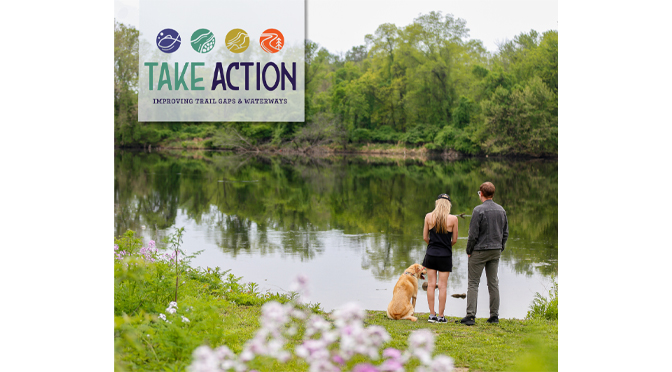|
|
(Easton, July 17) The Delaware & Lehigh National Heritage Corridor (DLNHC) launched its Take Action campaign on Monday July 17th to give D&L Trail users the tools needed to advocate for closing D&L Trail gaps and improving water quality within the National Heritage Area. The launch began with the unveiling of a new landing page on DLNHC’s website at delawareandlehigh.org/take-action/.
The Take Action campaign, with lead support provided by the William Penn Foundation, seeks to cultivate heightened levels of activity, engagement, and ownership among individuals affected by the remarkable natural, historical, and cultural resources of the DLNHC. By nurturing stronger connections with trail users across the Corridor’s three regions, DLNHC aims to unlock the full potential of trails, waterways, and heritage to foster enduring and sustainable benefits for all.
While it’s clear that D&L Trail users care about the Corridor’s natural resources and outdoor spaces, gathering the tools necessary to properly advocate for enhancements can prove intimidating. This campaign gives the public a series of talking points and clearly outlined steps that allow them to “take action” and support improvements in their community.
“The D&L Trail is visited over a quarter million times a year, and almost 60% (83 miles) of D&L Trail is within 100 feet of a stream or river,” says Brit Kondravy, DLNHC Conservation Coordinator and External Lead for the Lehigh Valley Greenways (LVG) Conservation Landscape. “Our past research has shown that these visitors are willing to do more than visit. They are willing to become a participating member of an organization that supports trails and/or water quality. They just need someone to help make those connections.”
The new landing page provides an overview of water quality and D&L Trail gaps within the Corridor, providing a base understanding of these topics. It dives into the issues facing water quality, the reasons trail gaps exist, and the benefits these resources provide for our region. Most importantly, it offers tools to advocate for improving and connecting these resources. These tools range from legislator locators, template letters to send to local officials, methods to find local meeting schedules, and links to additional resources and partner pages to get more engaged.
The DLNHC is a convener and supporter for multiple partners throughout the Corridor that make water quality and trail gap projects possible.
“Through our role in three regional trail coalitions and leadership of Lehigh Valley Greenways Partnership, the DLNHC can direct trail users to a variety of partners leading on-the-ground projects,” reports Kondravy. “The Take Action website highlights local watershed associations, riparian buffer planting opportunities, land conservation efforts, and Master Watershed Steward trainings through partners such as Watershed Coalition of the Lehigh Valley, Wildlands Conservancy, and Penn State Extension. In this way the LVG Partnership reinforces the DLHNHC’s call to take action and amplifies trail users’ ability to do so.”
The Take Action campaign will be celebrated through multiple partner events throughout the Corridor this summer. Visit the landing page and watch our social media @DelawareandLehigh on Facebook and @DLNHC on Instagram for more information.
The Delaware & Lehigh National Heritage Corridor is a 501(c)3 non-profit organization that preserves the historic pathway that carried coal and iron from Wilkes-Barre to Bristol. Through key programs like the D&L Trail, National Canal Museum, and Get Your Tail on the Trail, DLNHC connects people to nature, culture, communities, recreation, and our industrial heritage. For more information, visit delawareandlehigh.org/.
The William Penn Foundation, founded in 1945 by Otto and Phoebe Haas, is dedicated to improving the quality of life in the Greater Philadelphia region through efforts that increase educational opportunities for children from low-income families, ensure a sustainable environment, foster creativity that enhances civic life, and advance philanthropy in the Philadelphia region. Since inception, the Foundation has made nearly 10,000 grants totaling over $1.6 billion.







